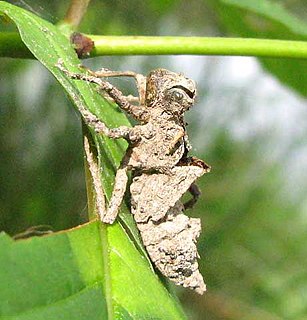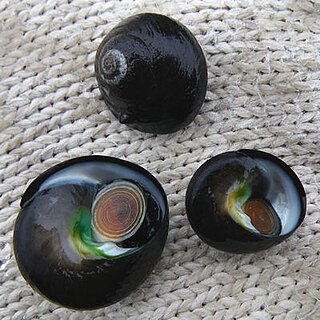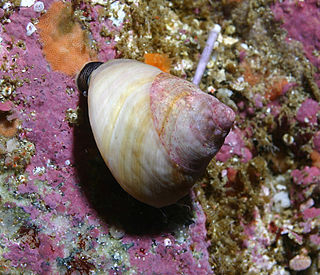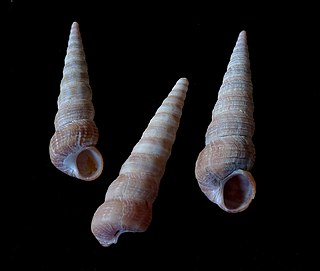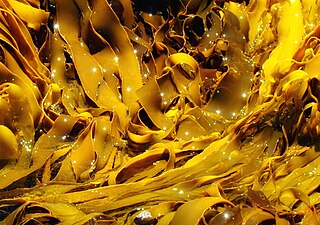
Kelps are large brown algae seaweeds that make up the order Laminariales. There are about 30 different genera.

Haliotis cracherodii is a species of large edible sea snail, a marine gastropod mollusk in the family Haliotidae, the abalones.
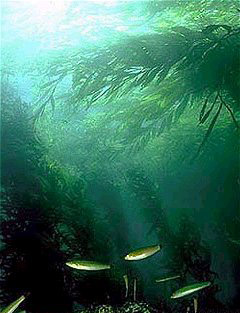
Kelp forests are underwater areas with a high density of kelp. They are recognized as one of the most productive and dynamic ecosystems on Earth. Smaller areas of anchored kelp are called kelp beds.
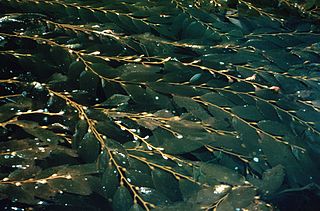
Macrocystis is a monospecific genus of kelp. This genus contains the largest of all the phaeophyceae or brown algae. Macrocystis has pneumatocysts at the base of its blades. Sporophytes are perennial and the individual may live for up to three years; stipes/fronds within a whole individual undergo senescence, where each frond may persist for approximately 100 days. The genus is found widely in subtropical, temperate, and sub-Antarctic oceans of the Southern Hemisphere and in the northeast Pacific from Baja California to Sitka, Alaska. Macrocystis is often a major component of temperate kelp forests.
Eisenia arborea, or the southern sea palm, is a dominant species of kelp that is found in the Northern and Eastern Pacific from Vancouver Island, Canada south to Isla Magdalena, Mexico, and along the coast of Baja California. They are commonly found from the midtidal areas stretching to the subtidal areas. It is an edible seaweed, a source of nutrients for grazing marine invertebrates and a source of alginic acid, a food thickener. Some of the algas have a hollow stripe above its holdfast with two branches terminating in multiple blades. Eisenia arborea is studied in order to predict environmental stress in oceans intertidal zones. Hollow stripes where present when the Eisenia arborea did not receive essential nutrients for its thalli development. Eisenia arborea with hollow stripes are believed to be evolved algae in order to increase their survival in harsh living conditions. They play a huge role in determining environmental stress.
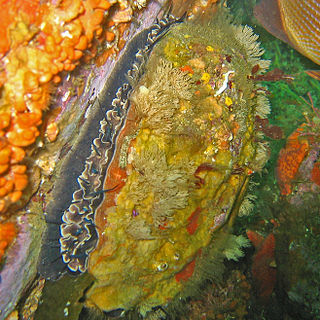
Haliotis rufescens is a species of very large edible sea snail in the family Haliotidae, the abalones, ormer shells or paua. It is distributed from British Columbia, Canada, to Baja California, Mexico. It is most common in the southern half of its range.

Loxechinus albus is an echinoderm of the family Parechinidae, native to coastal southern South America, ranging from Ecuador, along the entire coasts of Peru and Chile, to Argentina, as well as the Falkland Islands. It is known as the Chilean sea urchin or red sea urchin, but the latter name is typically used for the North Pacific Mesocentrotus franciscanus and it is not the only species of sea urchin in Chile. L. albus is found on rocky reefs and shores in the intertidal and subtidal zones to a depth of 340 m (1,120 ft).

Calliostoma ligatum, common name the blue top snail, is a small prosobranch trochid gastropod mollusk in the family Calliostomatidae, the Calliostoma top snails.

Macrocystis pyrifera, commonly known as giant kelp or giant bladder kelp, is a species of kelp, and one of four species in the genus Macrocystis. Giant kelp is common along the coast of the eastern Pacific Ocean, from Baja California north to southeast Alaska, and is also found in the southern oceans near South America, South Africa, Australia, and New Zealand. Individual algae may grow to more than 45 metres long at a rate of as much as 60 cm (2 ft) per day. Giant kelp grows in dense stands known as kelp forests, which are home to many marine animals that depend on the algae for food or shelter. The primary commercial product obtained from giant kelp is alginate, but humans also harvest this species on a limited basis for use directly as food, as it is rich in iodine, potassium, and other minerals. It can be used in cooking in many of the ways other sea vegetables are used, and particularly serves to add flavor to bean dishes.
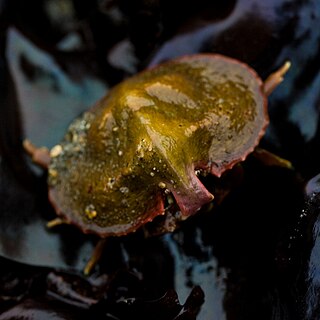
Cryptolithodes sitchensis, variously known as the umbrella crab, Sitka crab or turtle crab, is a species of lithodid crustacean native to coastal regions of the northeastern Pacific Ocean, ranging from Sitka, Alaska to Point Loma, California. Its carapace extends over its legs such that when it pulls in its legs, it resembles a small stone. It lives in rocky areas from the low intertidal to depths of 17 m (56 ft).
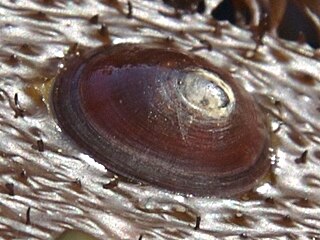
Discurria insessa, common name the seaweed limpet, is a species of sea snail, a true limpet, a marine gastropod mollusk in the family Lottiidae.

Nucella lamellosa, commonly known as the frilled dogwinkle or wrinkled purple whelk, is a species of sea snail, a marine gastropod mollusk in the family Muricidae, the murex snails or rock snails. This species occurs in the eastern Pacific Ocean, its range extending in the intertidal zone from the Aleutian Islands southward to central California.
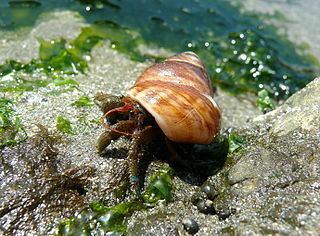
Pagurus samuelis, the blueband hermit crab, is a species of hermit crab from the west coast of North America, and the most common hermit crab in California. It is a small species, with distinctive blue bands on its legs. It prefers to live in the shell of the black turban snail, and is a nocturnal scavenger of algae and carrion.
Pterygophora californica is a large species of kelp, commonly known as stalked kelp. It is the only species in its genus Pterygophora. It grows in shallow water on the Pacific coast of North America where it forms part of a biodiverse community in a "kelp forest".

Aquaculture of giant kelp, Macrocystis pyrifera, is the cultivation of kelp for uses such as food, dietary supplements or potash. Giant kelp contains compounds such as iodine, potassium, other minerals vitamins and carbohydrates.

Margarites pupillus, common name the puppet margarite or the little margarite, is a species of sea snail, a marine gastropod mollusk in the family Margaritidae, the turban snails.
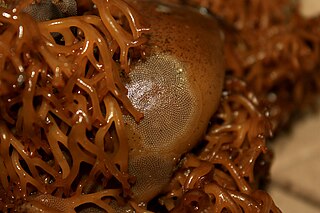
Macrocystis integrifolia is one of four species of kelp in the genus Macrocystis which grows to about 6 metres (20 ft) long.

Kelletia kelletii, common name Kellet's whelk, is a species of large sea snail, a whelk, a marine gastropod mollusc in the family Buccinidae, the true whelks.
Lytechinus pictus, commonly known as the painted urchin, is a sea urchin in the family Toxopneustidae. It occurs on shallow reefs in the tropical and subtropical eastern Pacific Ocean, off the coasts of California, Central America and South America as far south as Ecuador.
Lottia instabilis is a species of sea snail, a true limpet, a marine gastropod mollusk in the family Lottiidae. Common names include the unstable limpet, the unstable seaweed limpet and the rocking chair limpet. It is native to the northern Pacific Ocean where it feeds on kelp in the intertidal zone and the shallow sub-littoral zone.






